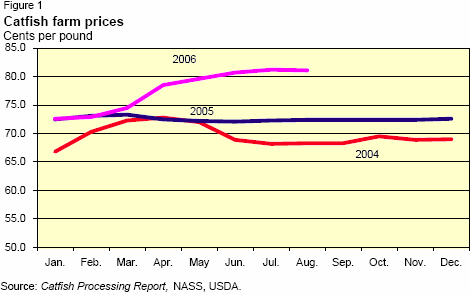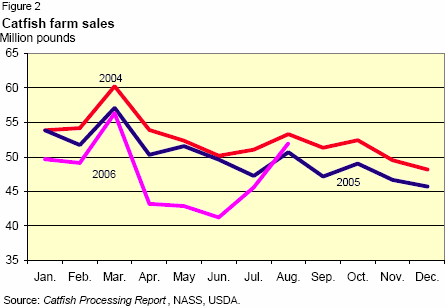
Domestic Aquaculture Competing Worldwide
Domestic seafood consumption in 2006 is likely to see a higher percentage of
overall consumption from foreign sources, a trend that has been going on for
some time. These imports stem in large part from foreign aquaculture
production. Almost all foreign countries are in the same situation as the
United States, with limited ways to increase their wild harvest fishing
industry, so they are expanding their aquacultural production.
The continued
growth of the Atlantic salmon and tilapia industries provides good examples
of how farm-raised product is being used in rapidly expanding parts of the
U.S. seafood industry. In both these industries almost all the domestic
production and all the foreign imports come from farmed production. The
questions for the U.S. aquaculture industry are how best to compete with
growing foreign production and how to determine which market segments
are most favorable for domestic producers.
The current economic outlook for U.S. aquacultural producers for the
remainder of 2006 and into 2007 is clouded by the wide swings in energy
prices over the last several weeks. After rapidly increasing earlier in the
year, energy prices are falling, but remain above year-earlier levels. The
domestic economic forecast is for relatively steady growth in the real Gross
Domestic Product through the remainder of 2006, and for slowed-but-steady
growth in 2007.
Real per capita disposable income is expected to be stronger
in the second half of 2006 and to continue to grow at a relatively strong rate
in 2007. Higher real disposable income, coupled with lower fuel prices,
would have a positive impact on the restaurant and foodservice sector. This
is critical to the aquaculture industry and the seafood industry overall, as they
make a larger percentage of their sales through the restaurant and foodservice
sector than the suppliers of traditional livestock and poultry products.
U.S. beef, pork, and poultry industries are all forecast to have increased production
in 2006 and 2007. In the wholesale market, the major price series for beef and pork
are forecast to be lower in 2006 and to fall again in 2007. For the domestic poultry
industry, overall prices are expected to be lower in 2006 and to increase slightly in
2007. These forecasts of increasing production and lower prices for the major
livestock and poultry protein sources mean strong competition for domestic and
imported aquaculture products.
This is the last issue of Aquaculture Outlook. Following this report, all aquaculture
material will be included, when timely information is available, in the monthly
Livestock, Dairy, and Poultry Outlook. A monthly report will give readers a more
current analysis of changing situations in the aquaculture industry. You can
subscribe to Livestock, Dairy, and Poultry Outlook (which includes Aquaculture
Outlook) at: http://usda.mannlib.cornell.edu/MannUsda/homepage.do.
In October 2 2006, the National Agricultural Statistics Service released the results
of the 2005 Census of Aquaculture. This report will update the material contained
in the 1998 Census of Aquaculture. The data in the report will cover production
method, water source, sales, distribution and farm labor. The report covers food
fish mollusks, crustaceans, ornamental fish baitfish, and sport fish.
http://www.nass.usda.gov/census_of_agriculture/2002/aquacultue/index.asp.
Domestic: Catfish Sales Down, but Prices Rise
Catfish sales have declined for the third consecutive year, but have again been
partially offset by higher prices. In 2006, sales by growers to processors are
expected to total between 550 and 565 million pounds, down from 2005 by 6 to 8
percent. Sales over the first 8 months of 2006 have been 380 million pounds, down
7.8 percent from the same period in 2005.
Catfish processor sales through August
2006 were also lower, at just under 200 million pounds, down 3 percent from the
same period in 2005. Unlike in previous years, the lower sales at the processing
level have resulted in a decrease in the inventory held by catfish processors. As of
the end of August 2006, processor-held inventories were 11.1 million pounds, about
1.8 million pounds (14 percent) lower than a year earlier.


Links
For more information view the full Aquaculture Outlook Report - October 2006 (pdf)
October 2006

